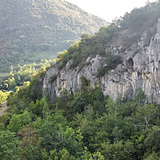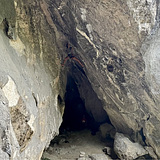🧗♀️Alliat is an optimal afternoon crag on vertical and overhanging limestone, with a collection of sectors situated a bit separate from each other, each facing east. The crag turns to shade in the mid-afternoon, at around 3 pm. The first sector provides some easy vertical climbing with short access. the rest of the crag is better for those climbing in the 7th and 8th grades. Alliat has routes on all slab, vertical and overhanging terrain and the routes are mostly single pitch ranging from 10 to 40 meters in length.
☂️The cave of Petite Grotte and Loubetiere provide shelter from sun and rain and are climbable around the year. During the hot summer months the caves of Petite grotte and Grotte Aux Fees provides a cool breeze to the closest routes.
👶The first sector of the crag is very child friendly with easy access. The rest of the sectors require approach on narrower path, and have thorny bushes on the approach.
SECTORS
The crag consists of multiple sectors, with sixdescribed in this topo. Some further sectors with longer approach are described in the local guide at cafma.free.fr. (Le Sablier, La Petite Mousse, Le Belvedére and Ventilo).
1. Grotte aux Fées
Easily accessible, the first sector of the crag offers the easiest routes, but also some harder ones. 6 minute walk from the Mairie parking.
📊 31 routes, 5 - 8a
2. 🧗♀️ Les Spoulgas
To access Les Spoulgas, continue the path past the Grotte aux Fées downhill until you see a wooden sign and path on to the left. The sector is named after a spoulga, a fortified cave, some of which can be found spread around the Ariege cliffs. This sector exhibits a fine specimen of a spougla.
📊 14 routes, 6b - 8a
3. La Loubétiere
Access sector La Loubetiere following the path past Grotte aux Fées and Les Spoulgas, until you find an intersection with a sign to the Grotte de la Vache. Here take the small path that lead downwards. When you encounter a cairn and a faint path to the left, take this path. Follow the path upwards and aim for the cliff you can see above.
📊 23 routes, 5 - 8b
4. La Petite Grotte
La Petite Grotte is a small cave that can provide a cool breeze on hot summer days. Access the sector via the same path that passes Grotte aux Fées, Les Spoulgas and the Grotte de la Vache. Go past the La Loubetiére cairn and intersection, and take the next path to the left to the Passe Murailles sector. At Passe Murailles the path takes a sharp left, and the Petite Grotte should be visible between the bushes, in 50 meters. The climbs from 7a and above are overhanging or traverse on the roof. Especially the roof routes that start at the right hand side of the cave entrance provide an unusual experience.
📊 14 routes, 5+ - 8c+
5. Passe Murailles
Access the sector via the same path that passes Grotte aux Fées, Les Spoulgas and the Grotte de la Vache. Go past the La Loubetiére cairn and intersection, and take the next path to the left and you will end up at the Passe Murailles wall.
📊 21 routes, 5+ - 8b
6. Mille Roc and Dolmen
Two small slabs of rock, accessed via a bit more overgrown paths, just past Passe Murailles.
📊 15 routes, 6a-8a
7. Le Livre
📊 32 routes, 6b-8b
The best routes in Alliat and maybe in the whole Ariége. Long overhanging routes in shade in the afternoon. Access the sector via the same path that passes the previous sectors and the Grotte de la Vache. Go past the La Loubetiére and Passe Murailles cairns and intersections. The path goes first down, then starts ascending and does one schicane, after which you will see le Livre on your left.



